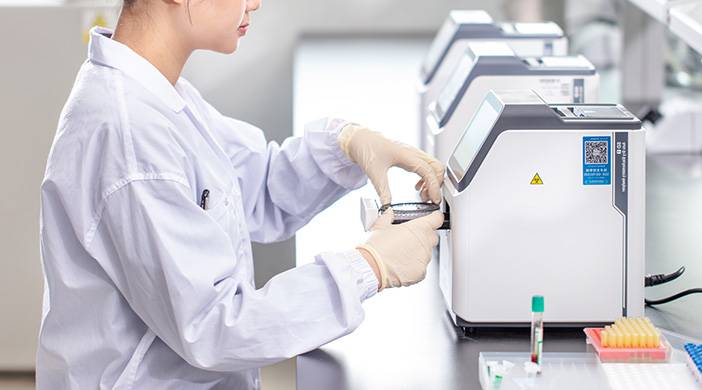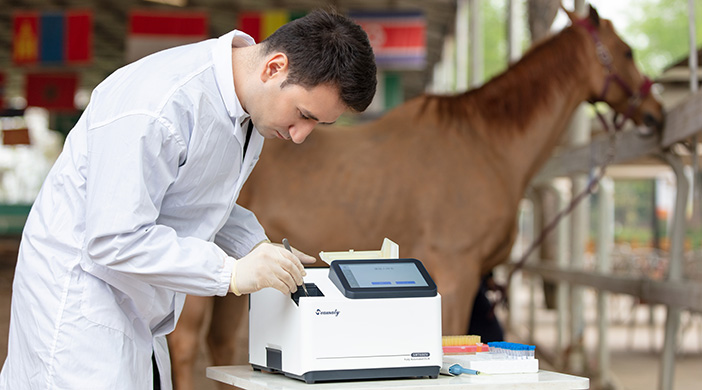release time:2021-04-21 10:34:22
Winter is a high incidence season of various diseases. Thus blood test is an important basis for clinical diagnosis.Blood biochemical testing is inseparable from blood collection. Blood collection using different colors of blood vessels, to represent different additives and usage
So when use Seamaty biochemistry, what precautions for blood vessels should we focus on?
When using whole blood for biochemical tests, only heparin-based anticoagulation tubes can be used.
Only 1:9 blue cover Sodium Citrate anticoagulant tubes can be used to measure coagulation function.
Do not use an EDTA anticoagulant tube in Seamaty
biochemistry tests because EDTA is an reaction inhibitor for many enzymes and
chelates metal ions such as calcium and magnesium, which are often activators
of many enzymes.
The use of EDTA anticoagulant tubes may have resulted in abnormal results in some of the projects, such as calcium and amylase.
With no anticoagulant, also called the biochemistry tube. The blood collection tube inner wall coating with medicament which can prevent wall hanging. It mainly uses in the blood biochemistry.
There are normal serum tube and fast serum tubes,
and the labels will indicate the state of with or without coagulant, or use red
and orange to distinguish the two types. The coagulant is used to accelerate
blood clotting. If you want to fast clotting to get results, you can use the coagulation
promoting tube.
Applicable sample type: serum
Applications: bacteria, tumor, gonad, immunologic routine, whole immunity, rheumatoid antibody, diabetic nephropathy test, blood trisection, ICA (insulin cell antibody) , GAD (Glutamate decarboxylase antibody) , ABAP (bone type alkaline phosphatase) , prostaglandin (T-PSA-F-PSA) , HBV-DNA, ferritin, cold agglutination, procalcitonin PCT, Mycoplasma antibody, gastrin, ANCA, blood Cytomegalovirus antibody, human epididymal epithelial secretion protein, serum protein electrophoresis, RA five items, TB-AD tuberculosis antibody.
Heparin is added to the blood vessels. It directly has the function of antithrombin, can prolong the clotting time of the samples. But excessive heparin will cause the accumulation of white blood cells, can not be used for white blood cell count. It can make the background of the blood pieces stained light blue, therefore, it is not suitable for classification of white blood cells.
Applicable sample type: whole blood, plasma
Applications: erythrocyte fragility test, blood gas analysis, HCT test, ESR and universal biochemical determination.
Containing heparin lithium or heparin sodium and gel. Heparin is a mucopolysaccharide containing sulfuric acid groups with a strong negative charge that strengthens the inactivated serine endopeptidase of antithrombin 3, thereby preventing the formation of thrombin, and has many kinds of anticoagulation function such as preventing the platelet aggregation. Normally, circumstances 15IU heparin anticoagulation 1ml blood. Heparin tubes are commonly used in emergency biochemical and hemorheological tests.
Sample type: plasma
Applications: TNT, environmental protection MYCIN, B27, blood ammonia, BNP (B-type natriuretic peptide)
Contains heparin sodium, EDTA NA2, EDTA K2,
coagulant (plastic tube, serum) and non-coagulant (glass tube, serum)
additives. When testing sodium ion in blood sample, no use heparin sodium to
avoid affecting the test result.
Application: micronutrient, toxicological and nutritional chemical tests
It contains EDTA anticoagulants. Compared with other anticoagulants, EDTA anticoagulants have less effect on the agglutination of blood cells and the morphology of blood cells. Therefore, EDTA salts (2K, 3K, 2Na) are usually used as anticoagulants.
EDTA salts bind to calcium ions in the blood to form chelates that prevent clotting.
Sample type: whole blood, plasma
Applications: 2 ml: blood routine, Reticulocyte, Glycated hemoglobin(HBAIC), TC blood group, BNP.
5 ml: pituitary, Parathyroid hormone, renin, adrenal function, adrenal cortex function ATCH + COR, cortisol (COR) , blood group + D antigen are not suitable for coagulation tests and platelet function tests, nor for calcium, potassium, sodium, iron, determination of Alkaline phosphatase, creatine kinase and leucine aminopeptidase and PCR test.
Contains inert separation gel and coagulant, the tube wall coated with coagulant can accelerate blood coagulation, avoid 37 °C water bath shorten test time. The separation rubber and the PET tube have the very good affinity, plays the isolation function.
Applicable specimen type: serum
Applications: 3ml: biochemical items, digoxin concentration, myocardial enzyme, amylase, thyroid function, thyroid function, free thyroid function, total Thyroid hormone, thyroid antibody, thyroid receptor antibody
5 ml: CRP (CRP immune, red or yellow) ,
HS-CRP
Contains 3.2% or 3.8% Sodium Citrate. Please take enough blood to ensure the accuracy of the test results. Immediately mix it upside down 5-8 times after taking blood. The ratio of anticoagulant to blood is 1:9.
Applicable specimen type: whole blood, plasma
Applications: fibrinolytic system (prothrombin time, thrombin time, activated partial thrombin time, fibrinogen) .
Contains 3.2% (0.109 mol/L)-3.8% Sodium Citrate. The ratio of anticoagulant to blood is 1:4. When the ratio of anticoagulant is too high, the blood is diluted and the sedimentation rate is increased. Heparin anticoagulants alter the potential of red blood cells and are therefore not suitable for erythrocyte sedimentation rate testing,
Suitable sample type: whole blood
Application: blood-sedimentation
The additive in the tube is sodium fluoride + potassium oxalate/sodium fluoride + heparin sodium. Sodium fluoride is a weak anticoagulant and has a good effect in preventing the degradation of blood sugar. Sodium fluoride + potassium oxalate/sodium fluoride + sodium heparin mixture 4mg can make 1ml blood not coagulate and inhibit sugar decomposition for 23 days. Please pay attention to slowly inverting and mixing when using.
Applications: blood glucose testing, can
not use urea for urea enzymatic determination, can not be used for the
determination of Alkaline phosphatase and amylase.
In the blood collection, according to the
different test items, we need to choose the right blood collection vessel to
avoid abnormal test results.
If you have any problems with Seamaty instruments and need help, please send your question to this email address: sales@seamaty.com We will get back to you as soon as possible.

2021-06-09
POCT, abbreviation for Point of Care Testing, is a branch of the in vitro diagnostic (IVD) industry that can be understood as clinical and bedside tests performed next to the patient.

2021-04-21
The different colors of blood collection tubes used in blood collection represent different additives and uses.

2021-05-20
Biochemistry Analyzer has a medical and animal version. Many people will have questions, that can human biochemistry analyzer be used to detect animals?